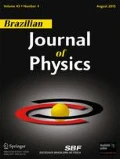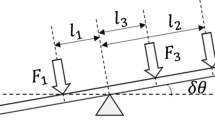Abstract
We re-examine the (inverse) Fermi accelerator problem by resorting to a quantum trajectory description of the dynamics. Quantum trajectories are generated from the time-independent Schrödinger equation solutions, using a unipolar treatment for the (light) confined particle and a bipolar treatment for the (heavy) movable wall. Analytic results are presented for the exact coupled two-dimensional problem, as well as for the adiabatic and mixed quantum-classical approximations.





Similar content being viewed by others
Notes
Strictly speaking, in Ulam’s model, the second wall is oscillating periodically. However, we shall restrict our consideration to the simpler model for which the moving wall interacts only with the particle.
In previous work by author Hussein, this was referred to as the “semiclassical” or “semiquantal” approach, but we wish to avoid confusion with the altogether different WKB approximation. In any event, such approximations are typically referred to as “mixed quantum-classical” in the physical chemistry literature.
Again, in the physical chemistry literature, “Born-Oppenheimer approximation” often refers to a quantum treatment of the electrons, parametrized by definite nuclear geometries which may or may not be moving in time. It is also used in the sense of the previous work by author Hussein, to mean a weakly separable approximation in which both light and heavy particles are treated quantum mechanically. In this paper, the latter is referred to as the “adiabatic approximation.”
The moving wall idea also emerges in a time-dependent quantum treatment, although that remains beyond the scope of the present submission.
References
E. Fermi, Phys. Rev. 75, 1169 (1949)
S. Ulam, in . Proc. 4th Berkeley Symposium on Mathematics and Probability 3, 315. Berkeley, Los Angeles, (1961)
V. Gelfreich, V. Rom-Kedar, D. Turaev, Chaos. 22, 033116 (2012)
M.S. Hussein, V. Kharchenko, Ann. Phys. 250, 352 (1996)
M.S. Hussein, M.P. Pato, V. Kharchenko, Braz. J. Phys., 27 (1997)
J.-B. Shim, M.S. Hussein, M. Hentschel, Phys. Lett. A. 373, 3536 (2009)
K. Alder, A. Winther, Phys. Rev. 91, 1578 (1953)
H.D. Marta, L.F. Canto, R. Donangelo, Phys. Rev. C. 78, 034612 (2008)
L.F. Canto, M.S. Hussein. Scattering Theory of Molecules, Atoms and Nuclei (World Scientific, Singapore, 2013)
B.V. Carlson, M.S. Hussein, A.F.R. de Toledo Piza, L.F. Canto, Phys. Rev. C. 60, 014604 (1999)
B.V. Carlson, R. Capote, ajd M. Sin, Few-Body Systems. 57, 307 (2016)
M. Kleber, Phys. Rep. 236, 331 (1994)
D. Bohm, Phys. Rev. 85, 166 (1952)
P. R. Holland. The Quantum Theory of Motion (Cambridge University Press, Cambridge, 1993)
R. E. Wyatt. Quantum Dynamics with Trajectories: Introduction to Quantum Hydrodynamics (Springer, New York, 2005)
B. Poirier, J. Chem. Phys. 121, 4501–4515 (2004)
C. Trahan, B. Poirier, J. Chem. Phys. 124, 034115 (2006)
C. Trahan, B. Poirier, J. Chem. Phys. 124, 034116 (2006)
B. Poirier, G. Parlant, J. Phys. Chem. A. 111, 10400–10408 (2007)
B. Poirier, J. Chem. Phys. 128, 164115 (2008)
B. Poirier, J. Chem. Phys. 129, 084103 (2008)
D. Babyuk, R.E. Wyatt, J. Chem. Phys. 124, 214109 (2006)
B. Poirier, Chem. Phys. 370, 4 (2010)
J. Schiff, B. Poirier, J. Chem. Phys. 136, 031102 (2012)
G. Parlant, Y.-C. Ou, K. Park, B. Poirier, Comput Theoret. Chem. 3-17, 990 (2012)
B. Poirier, Rev, Phys. X. 4, 040002 (2014)
H.-M. Tsai, B. Poirier, J. Phys. 701, 012013 (2016)
Y. Scribano, G. Parlant, B. Poirier, J. Chem. Phys. 149, 021101 (2018)
A. Bouda, Int. J. Mod. Phys. 18, 3347 (2003)
P. Holland, Ann. Phys. (NY). 315, 505 (2005)
P. Holland, Proc. R. Soc. London, Ser. A. 461, 3659 (2005)
M.F. González, X. Giménez, J. González, J.M. Bofill, J. Math. Chem. 43, 350 (2008)
B. Poirier, Phys. Rev. A. 56, 120–130 (1997)
A. Shapere, F. Wklczek. Geometric Phases in Physics (World Scientific, Singapore, 1989)
P.R. Bunker, P. Jensen. Molecular Spectroscopy and Symmetry (NRC-CNRC, Ottawa, 1998)
D.J. Tannor. Introduction to Quantum Mechanics: A Time-dependent Perspective (University Science Books, Sausalito, 2007)
M. Abramowitz, I.E. Stegun, Handbook of Mathematical Functions, p. 366, U.S Department of Commerce (1972)
M.F. Kling, M.J.J. Vrakking, Annu. Rev. Phys. Chem. 59, 463 (2008)
Acknowledgments
Both authors extend their thanks to J-M. Rost for the hospitality extended to them in Dresden. BP expresses his deep sorrow for the loss of his esteemed colleague and co-author, who passed away during the initial preparation of this manuscript. Among the myriad research topics of interest to the legendary MSH, BP is honored and humbled to be able to present MSH’s Fermi accelerator contributions as part of this special issue.
Funding
This work was partly supported by The Robert A. Welch Foundation (D-1523) and by the Brazilian agencies, Fundação de Amparo à Pesquisa do Estado de São Paulo (FAPESP), and Conselho Nacional de Desenvolvimento Científico e Tecnológico (CNPq). MSH acknowledges a Senior Visiting Professorship granted by the Coordenação de Aperfeiçoamento de Pessoal de Nível Superior (CAPES), through the CAPES/ITA-PVS program. Primary support, however, is through a joint grant from the SPRINT FAPESP/TTU program (2016/50485-9), which both MSH and BP share. BP also acknowledges support from the MPIPKS during his six month stay at the Institute (February-August, 2018).
Author information
Authors and Affiliations
Corresponding author
Additional information
Publisher’s Note
Springer Nature remains neutral with regard to jurisdictional claims in published maps and institutional affiliations.
Rights and permissions
About this article
Cite this article
Hussein, M.S., Poirier, B. Quantum Trajectory Description of the Time-Independent (Inverse) Fermi Accelerator. Braz J Phys 51, 193–203 (2021). https://doi.org/10.1007/s13538-020-00825-z
Received:
Accepted:
Published:
Issue Date:
DOI: https://doi.org/10.1007/s13538-020-00825-z



